|
|
Icelandic Sheep Articles |
***note see other articles about Icelandic sheep below
jThe
Dancing Dairy Shepherd of True North Farm j
Copyright
2005 by Susan Mongold Briggs /
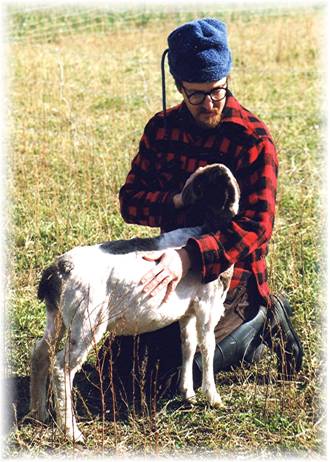 Jim Londagin, shepherd
Jim Londagin, shepherd
I first became aware of Jim Londagin when he called to pick
my brain about the possibility of using Icelandic sheep as a dairy breed. He had
worked on several sheep dairies that had East Friesians and didn’t like their
health problems, poor lamb survival rate and high inputs of grain needed to keep
them milking at the top of their abilities. He thought that perhaps a cross with
a heartier breed might work. He soon became intrigued with the Icelandic breed.
Jim was a full-steam-ahead person and soon he knew the genetics and production
records of every sheep in my flock and in every one else’s flock better anyone
else. His goal was to put together a dairy flock of Icelandics and have the
first commercial Icelandic dairy in the world that would support himself and
Harry (his life partner). He told me more than once that his goal was to get
Harry out of his city job before it killed him. While traditionally Icelandics
have been used as a dairy animal for centuries on farms in
 Jim
with hat ideas
Jim
with hat ideas
What many folks did not know was that before Jim’s sheep
career started he was a professional dancer, a very good one, a ballet dancer
classically trained by The New York Ballet which is one of the best ballet
companies in the world, and that Jim was selected for this training at the age
of 16 from hundreds of young hopeful dance prospects. He was one of the youngest
ever selected. But Jim, the young man from
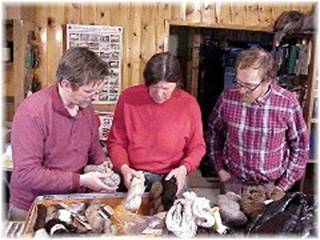 Harry
and Jim look over my Icelandic yarn collection
Harry
and Jim look over my Icelandic yarn collection
The plan was for Harry to continue working and bankroll the
project until the farm was able to support them both. Soon Jim and Harry had a
farm rented, put together a small starter flock and had a milking parlor and
equipment set up to start milking. That was the start of True North Farm. Jim
started reseeding the neglected farm fields with clovers and improved grasses
for a dairy sward and set up a rotational grazing system. When the farm water
well was found to be unsuitable for dairy use and the owner wouldn’t drill a
new one Jim and Harry decided to find a new home for their flock and dairy. j
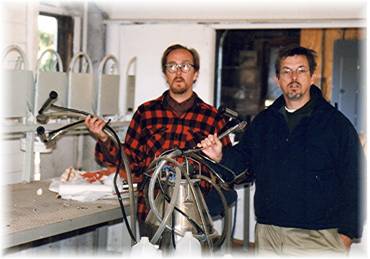 First
milk parlor set up
First
milk parlor set up
A partnership with Harry’s sister Mike Kelley and her
husband Ron Kittel resulted in a new True North Farm in the Catskills on top of
the mountain with a fabulous view. The property included an old resort hotel and
an apartment building. The fields were neglected and unfenced but promising. The
view was spectacular. While the new farm was being renovated Jim learned more
about milking, dairying, cheese making, sheep genetics, pasture management,
rotational grazing, sheep nutrition, and all related subjects. He put on lambing
seminars, and help put on the week long Judith Mackenzie fiber workshop at the
farm making all of the meals himself for the participants. (Did I mention that
Jim was a gourmet cook?) He also worked with a series of interns teaching them
what he knew and infecting them with a love of the sheep and dairy. He had so
much knowledge to offer those that wanted to learn. With his lanky frame and
supple body you could tell by the way he moved that he had a dance trained body.
He was always positive and rarely depressed or discouraged. He was funny and
playful and would make the most interesting costumes from ordinary things. He
would turn a purse into a stylish hat, a few common food ingredients into
gourmet fare, some cull fiber into designer yarn. He had unlimited energy and
ran circles around everyone. He was also deeply religious and practiced his
beliefs. He was driven and in a hurry to achieve his dreams of a sheep cheese
business. Even when things later on looked grim he kept his hopeful attitude and
had a “can do” attitude. He identified milky lines in the Icelandic breed
and set out to develop these lines. He knew every one of his sheep and every
nuisance in each one’s behavior, conformation and performance. j
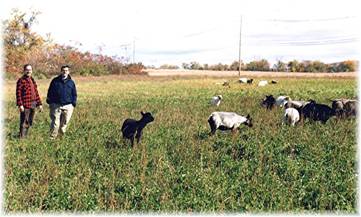 Jim
and Harry with their first flock on dairy quality fall pasture.
Jim
and Harry with their first flock on dairy quality fall pasture.
He wanted to start making progress fast but could not
bankroll a large purchase of sheep to get started. Undaunted by this roadblock
he asked me if he could lease a group of ewes from me to get started. I knew
that this would be a gamble, but if Jim were successful in proving the value of
the Icelandic sheep as a dairy breed this would pay big dividends for the breed
as a whole. So I leased Jim and Harry about 40 ewes. Jim and Harry drove across
country from
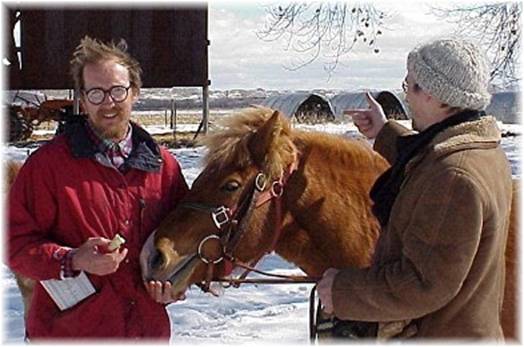 Ready
to ride an Icelandic horse in
Ready
to ride an Icelandic horse in
He seemed to always be in a hurry to push the farm on
toward the goal of self-sufficiency and eventual profitability with a cheese
making operation. No two people I knew had more potential than this team of Jim
and Harry. With Jim’s enthusiasm and drive, knowledge about sheep, dairying,
costuming and food and Harry’s knowledge about advertising, language and fiber
they were an unbeatable team. However, soon difficult illnesses threatened
Harry’s health, life, profession and income and he was forced to retire. Jim
pushed on as much as he could with drastically decreased finances. But he
managed to milk the sheep, import semen from
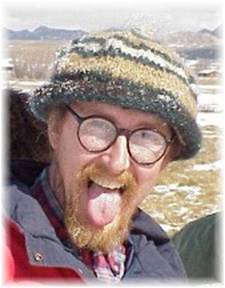 Jim
wears the handspun, hand knitted, hand dyed hat that Harry knitted for him
Jim
wears the handspun, hand knitted, hand dyed hat that Harry knitted for him
There was more to dairy ewe selection than just milkiness.
Jim found that the ewe had to also be of the temperament to relax in the parlor
and let down her milk fast, readily and completely. He found the Icelandics easy
to train to the parlor routine. The ewes learned in just a few sessions where to
come in and just what to do to get the grain reward in each slot of the
stanchion. Udder conformation was critical in insuring that the udder would milk
out completely. Icelandics had good dairy udders, for the most part, that
emptied out without lifting the bottom of the udder. Ewes that would graze readily in the hot summer and keep milking through
the heat were selected from the flock. Ewes that allowed their udders to be
handled without getting upset were also selected for use in the parlor. Jim soon
found out that the milk that the Icelandics gave from dairy quality pasture and
little grain was of the highest quality. The cheese maker at Old Chatham where
Jim sold his milk for 3 years said that the milk from the True North Icelandics
was the finest sheep milk that he had ever used. It had high butterfat and
solids, and a low somatic cell count. It yielded a larger amount of higher
quality cheese per gallon when compared to the milk from the
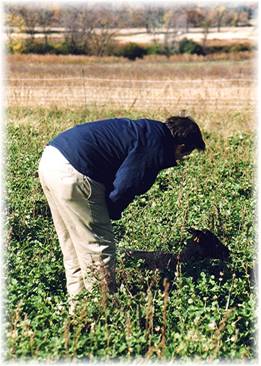 Harry inspects a resting
ewe in lush fall dairy pastures that Jim planted
Harry inspects a resting
ewe in lush fall dairy pastures that Jim planted
A New dairy barn was built on the Catskill mountain farm
and the pastures reseeded. That first year on this farm the first milk was
shipped to Old Chatham for processing into cheese. The plan was to get a cheese
making room as well as a cheese ripening room built. These plans were slowed to
a crawl when Harry’s health took a sudden bad turn and he was unable to work
and bankroll the start-up operation. Without this input of capital, progress on
the dairy was slow and difficult. Finally the partnership dissolved when the 4
partners found that they had different visions of which way to proceed. Jim and
Harry left the farm with a contract to buy another farm within a few weeks. The
farm in
I
had called to get some strength for the problems that I was going through with
the move to MO and the hard task of going it alone in my first year. I never got
too much chance to tell him my woes but I got what I had called for in the
message that I should just go out that day and do whatever it was that needed to
be done that I was able to do. I also felt that my problems were small compared
to what Jim was going through (you know the parable of the man who feels sorry
for himself cause he has no shoes till he sees a man that has no feet). And Jim
was that man with no feet for me and yet he was still dancing through life
managing somehow to stay focused on the goal and on the good things in his life.
I hung up the phone and felt grateful to have such a wonderful friend as Jim who
didn’t even know that he had helped me. j
Finally the purchase of the
 Harry
Harry
Harry wrote to his fiber list this poetic and poignant
message the next day:
Subject: We Do Not
Lose Heart by Harry Kelley
Did anyone see how bright the stars were last night?
Weep, too, for the beauty of the
Did anyone hear me calling for Jimmie when I
couldn't find him? The stars did.
Orion hovered over us
A
ton of hay. When I found him he was under a round bale that had rolled down the
A
neighbor and I got the bale off. I knew immediately why the stars
were
singing so clearly in the dark, cold, life-giving night.
I did the resuscitation routine while waiting for those who come to come.
I
knew it
Many
people came and wept. And before the shuffled mortal coil left the beautiful
When
you finish spinning the skeins, and weaving the thing that loves, it goes away.
Our
last month was so perfectly happy. Sing ye wheels and whirl ye spindles, for the
kindness
of the Heart of All Compassion gave us fathomless blessings in these last
Did
you hear the watch dogs barking? One by one they came over and sniffed the
I
am planning to have a funeral--I hope on Saturday but someone will post when the
We'll
build a coffin in the next day or so from scrap
I
am plunged deep into the heart of mercy now. I grieve, but I cannot see this as
How
Remember when we sang at Marge's funeral, Jimmie? From the
Russian Burial
Did
you see? Did you see the sky?
Quill
(Harry)
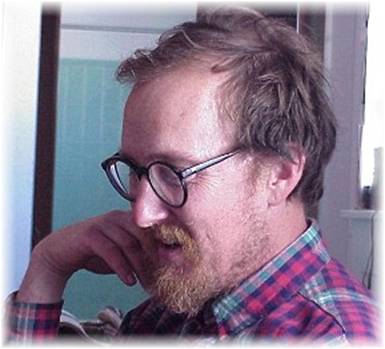 Jim
Jim
A
call from Barbara Webb the next morning jolted me out of bed when she relayed
the news about Jim. For the whole day I was in shock and denial. NO this
couldn’t be, NO this was
a cruel trick, NO I
wasn’t ready to lose Jim, NO Jim had
so much to give us and this knowledge would now be lost, NO just when
Jim and Harry were finally on their new farm and the dream was just starting to
take off again…… yet again…. in a new start… (“third time is a
charm!”) …. NO! NO!
NO! …. L I called
folks all day long and wept with them at our loss. j
The
Icelandic and dairy sheep world was stunned and distraught with grief over
Jim’s death. Folks showed up from far and wide to come and help to care for
the sheep and Harry, to say goodbye to Jim and do what they could. The funeral
was a unique event. Before the funeral the coffin was placed in the sheep pen
where it seemed fitting for Jim to be in the company of his beloved sheep.
Friends made his casket with old barn boards found around the farm. Friends
carried his coffin to the river to say their goodbyes. Actors, performers and
dancer friends from
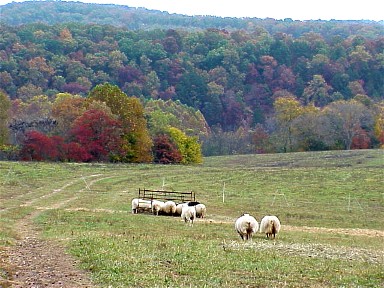 …..Still pastures
…..Still pastures
After the funeral was over the plans were started to sell
and disperse the flock. Being “homeless” for a year in trying to buy the new
farm hadn’t helped the record keeping. So Jim’s records were few,
fragmented, and in disarray with some still packed away from the move. He had
kept many of his records in his head. His Scrapie Program status had not been
updated since his move from
I
realize now why Jim was always in such a hurry to push ahead with his plans for
the sheep and the farm. Somehow he knew that he didn’t have too much time and
needed to get things done as fast as possible before he had to leave. Leave…
no maybe that is not the right word cause Jim is still here with us in out
hearts and thoughts and in our everyday way that we deal with problems. j
Jim
taught me to not sweat the small stuff, not to get caught up in the politics and
infighting of the sheep world and to forge ahead with my dreams. He taught me
that others could not see that dream and there was no use in trying to get them
to see it. I am grateful to have had such a wonderful friend as Jim who didn’t
even know how much he had helped me through the years. He led in the best way by
example. His life was a gift to all of us and we were addicted to that loving
man and his bright light in our lives. I was so lucky to have known Jimmy.
…. Jim Londagin, Dancing Dairy Shepherd and Friend! j
--------------------------------------------------------
CLICK on the titles in red (below) to read the article
Colour Inheritance in Icelandic Sheep and Relation between Colour, Fertility and
Fertilization
by Stefan Adalsteinsson Ph.D. , Journal Agriculutural Research Iceland,
1970 Vol 2, 1 Pg 3-135
A Black-Moorit Mosaic-Colored Icelandic Ram
by S. Adalsteinsson, The Journal of
Heredity 1984 vol 75 pg 83-84
Coloured Sheep and Their Products
Papers presented at the World Congress New
Zeland Jan 1984 pg 36-41
Icelandic Sheep in Canada
by Stefania Sveinbjarnardottir-Dignum, Black Sheep
Newsletter, issue #48 Summer 1986, pg 1,7,8
Icelandic Sheep
by Stefania Sveinbjarnardottir-Dignum, Spin-Off magazine, June 1988,
pg 58-9
Reproduction, Growth and Nutrition in Sheep: Dr. Halldor Palsson Memorial
Publication
Edited by Dr. O.R. Dymundsson and Dr. S. Thorgeirsson 1989 pg 213
The Icelandic Fleece- a Fiber for all Reasons
by Beth Abbott, Bulletin Magazine of the
Ontario Handweavers and Spinners, Winter 1990/ Vol 33 #4
Rettir- The Fall Roundup and Penning of Sheep in Iceland
by Stefania
Sveinbjarnardottir-Dignum, The Shepherd, Dec 1990 pg 10-14
Iceland's Fight Against Sheep Diseases
by Stefania Sveinbjarnardottir-Dignum, The
Shepherd, Aug 1991, pg 18-20.
Wool Combing and Primitive Fleeces! Icelandic, Navajo-Churro and Norwegian
Spaelsau
by Mary Iselin, Black Sheep Newsletter, issue #73 Fall 1992 pg 1,4-12
Leadersheep
by Stefania Sveinbjarnardottir-Dignum, Black Sheep Newsletter, issue 75
Spring 1993 pg 1,5,7
Fascinating Colour and Pattern Genetics of Icelandic Sheep
by Stefania
Sveninjarnardottir-Dignum, Blanc Sheep Newsletter, issue 79 Spring 1994 pg. 1,5,7
Icelandic Sheep: One of the Oldest Pure Breeds, Descends to the Vikings
, Record
Stockman 1995
Icelandic Sheep: An Old Breed with New Possibilities
by Susan Mongold, Record
Stockman, 1996 pg 9
Icelandic Sheep at Home in Montana
by Susan Mongold, Montana Woolgrowers,
Sept/Oct 1996 pg 60-61
Icelandic Sheep: An old breed with new possibilities
by Susan Mongold, Countryside
and Small Stock Journal, Vol 80 #5 Sept/Oct. 1996
100 Years of Lopi
Knitters Magazine, Winter 1996, #45 vol 13 #4 pg 20-30
Icelandic Sheep
by Stefania Sveinbjarnardottir-Dignum, The Shepherds Journal,
July/Aug 1997, pg 11-14.
Color Genetics in Icelandic Sheep
by Susan Mongold, The Shepherd, June 1997 Vol 42
#6, pg 11-16
Knitting a Klukka
by Louise Heite, Knitters Magazing, vol ? no ? pg 26,27
Icelandic Sheep
by Darlene Polachic, Sheep Canada, Winter 1997 pg 3,8
Icelandic Sheep: One of Iceland's Joys
by Stefania Sveinbjarnardottir-Dignum,
Record Stockman, Sept. 19, 1997, vol #40 pg 11.
Rare Icelandic Sheep Serve Dual Purpose
by Susan Mongold, Grainews Aug 1997, pg
33-34
A Flock with Golden Fleece
by Raylene Nickel, Cooperative Partners-to enhance
farmer/rancher profitability, September 1998, pg 22-3
Icelandic Knitting
by Louise Hiete, Knitters Magazine vol ? #? pg 22-3
Scandinavian Sheep
by Priscilla A. Gibson-Roberts, Knitters Magazine, vol? #? pg 19-
20
THE LEGENDS HAVE ARRIVED: Frist-time Icelandic Sheep Semen Importation Set
by Susan Mongold, Record Stockman ??, Oct. 1998 ??
Three years needed for import AI
by John Halbert, Miles City Star, Dec. 9th, 1998
Sheep AI needs specialized skills, gear and techniques
by John Halbert, Miles City Star, Dec. 9th, 1998
Icelandic Knitting
By Louise Heite, , Page Number 22 Knitters Magazine
Scandinavian Sheep
By Priscilla A. Gibson-Roberts ,, Knitters Magazine
The Icelandic Fleece - a Fibre for all Reasons
by Betb Abbott, Winter 199O; Volume 33; Number 4 issue of the Bulletin, Magazine of the Ontario Handweavers & Spinners.
|
Home | Breeding Stock | Products | Contact Us |
|
|
All
photos, graphics, and text: © Copyright Tongue River Farm, 2002 |
